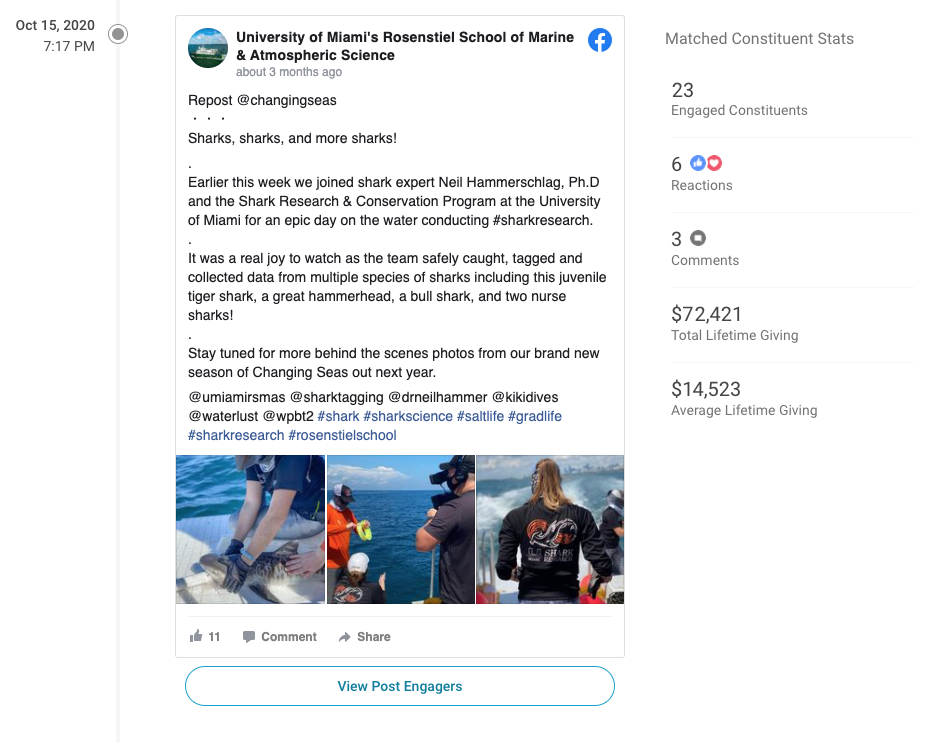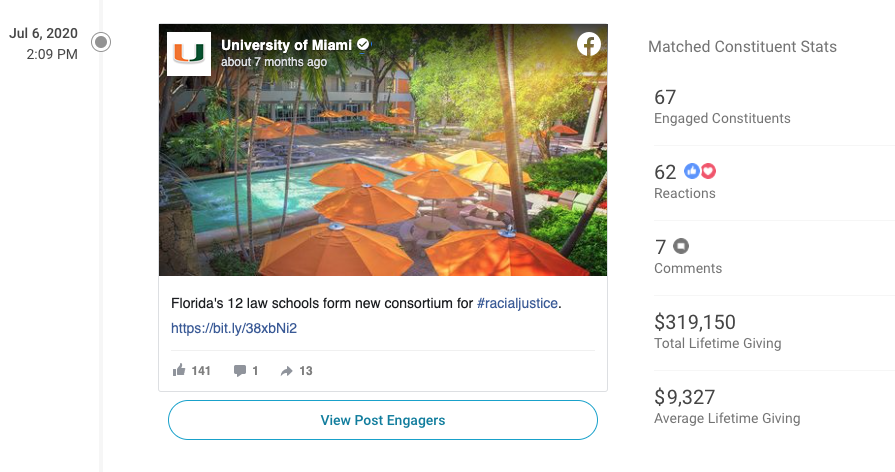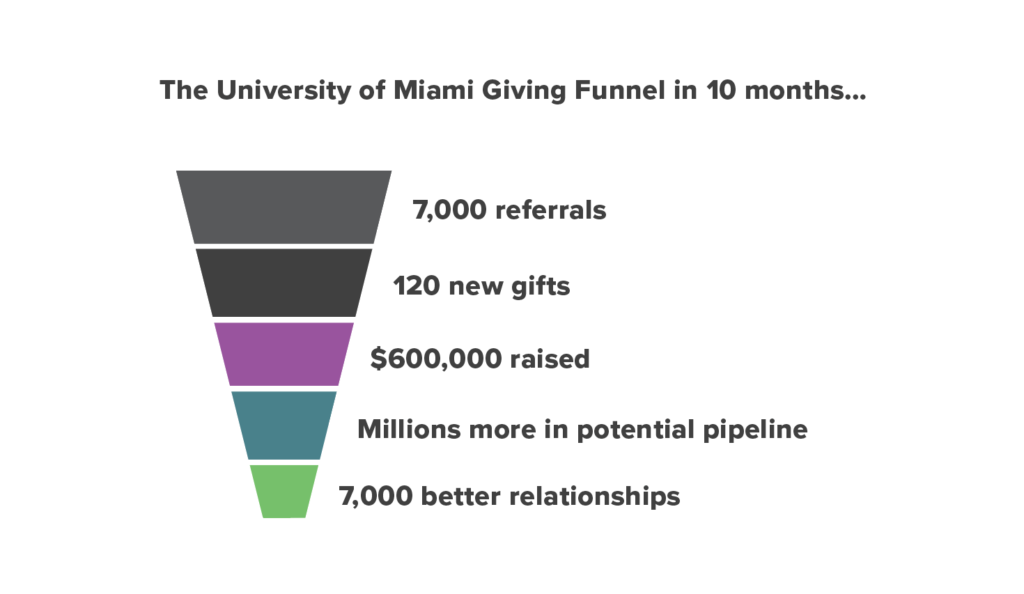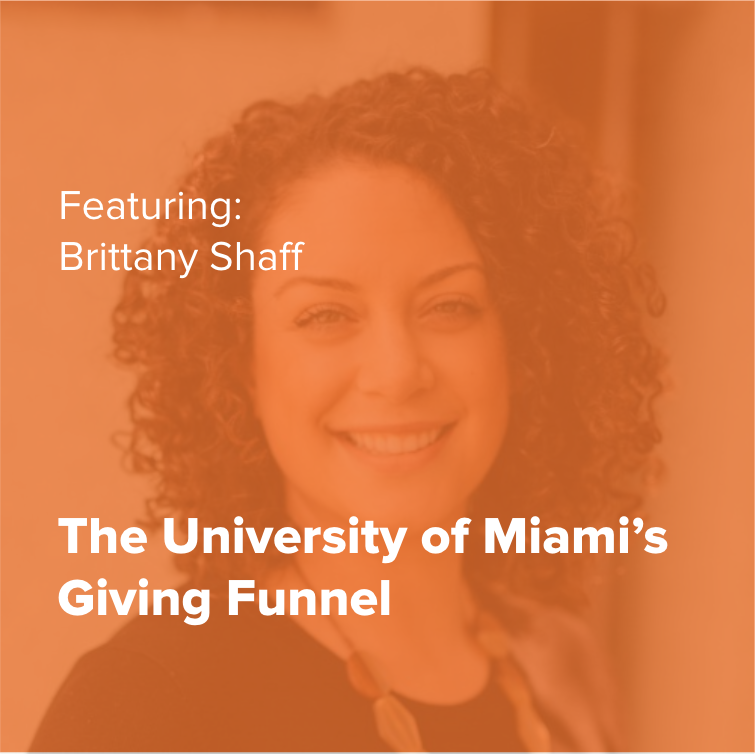Here’s how the University of Miami used Facebook to surface 7,000 leads for frontline fundraisers, helping close 120+ gifts worth $600,000 and creating millions more in pipeline — all in the last 10 months.
Think about the last thing you researched before buying online.
Maybe it was an exercise bike or a new pair of shoes.
You probably heard about it from a friend. Googled it. Read reviews. Watched a video about it that popped up on YouTube or Facebook or Instagram. Made a decision. Bought the item. Then posted a selfie with it when it arrived.
That’s a typical customer journey.
Now compare it to the alumni donor journey.
You graduate. Your college sends you a postcard and/or email every three months asking for a gift. Sometimes you give. Sometimes you don’t. Years later, you make a lot of money, the college finds out, and they send a gift officer to ask you to make a big gift. Maybe you will. Maybe you won’t.
What if the journey from digital engagement to major gift donor was more like the customer journey?
Alumni engage with their college online, the university looks at those interactions, shares a relevant story as a follow-up, and the next appeal or face-to-face ask connects back to the original engagement point.
That’s the Giving Funnel. And it’s alive and well and growing revenue at the University of Miami.
Using Facebook as a source for leads
We’ve written about this before, but when alumni and donors interact with Facebook posts, they’re letting you know that they care.
They’re raising their hand for attention.
Brittany Shaff, Assistant Vice President of Digital Engagement + Philanthropic Giving, leads the digital engagement + philanthropic giving teams in the University of Miami’s Office of Development and Alumni Relations.
With hundreds of thousands of followers across dozens of Facebook pages, Brittany and the Miami team saw untapped potential within their fans’ Likes, Loves, and Comments.
“I actually don’t think that we’re in a digital transformation,” Brittany said. “I know a lot of people think that we are. But we’re actually in a digital imperative.”
And this is what fundraising should look like in our digital-first world.
Share stories that alumni want to hear AND connect them to fundraising priorities
Before they started referring digitally engaged prospects to gift officers, Brittany and the team first stepped back and took stock. They analyzed how their alumni talked about Miami online, then created a content strategy that married what graduates wanted to hear to fundraising priorities for the U.
“We wanted to understand each channel — who’s talking about us, what are they saying about us, and what do they want from us? And then we adapted our content to that.” Brittany said. “We took that information and matched it to our solicitation strategy, so what people say about each school or college connects to the stories in our solicitations.”
Then we started putting out posts like this one about shark tagging from our Rosenstiel School of Marine and Atmospheric Science. This post matched a solicitation that went out the same week about the same topic.”

Look at who’s engaging with your posts, then continue engaging them
“We use EverTrue to look at anyone who interacts on Facebook about any topic that connects back to a fundraising priority,” Brittany said. “So in this case, using shark tagging as an example, someone from our team follows up within two business days with additional information.
We say something simple like, ‘Hi, I came across this article about shark tagging. I thought you might find it of interest. Check it out and let me know what you think.’”
By following up quickly with personal outreach, the Miami team is creating a great experience for alumni and doing it in a way that shows they understand the interests of each donor.

Refer these engaged leads to gift officers
As the digital engagement team starts conversations with alumni, families, and other constituents, they share those exchanges and donor profiles with Miami’s major gifts team or engagement officers — region and affinity-based development staff who are responsible for both frontline fundraising and programs.
“It used to be about having a million followers, but now it’s about what did we do with those followers? How can we convert them to be either heightened engagers or givers?” Brittany said. “So we follow up quickly with people who responded to our posts with an email or text, and if they respond, we consider that individual as a warm lead and refer them to a member on our engagement team.”
It’s important to note that Miami does all of this with a digital engagement team of three. They take turns reaching out to constituents and share more information about each topic. While they’d love to automate some of this in the future, it’s all one-on-one, person-to-person communication — meaning any shop of any size can do exactly what they’re doing.
Gift officers follow up with a qualification conversation. They already know what will pique interest.
Once gift or engagement officers receive a lead, it’s up to them to continue the conversation. It’s an effective launching point for qualification.
“We say, ‘I think you should reach out to this person. He’s actively talking to us now on digital channels, here’s his capacity, here’s his previous giving, and this is why he may be more interested in this topic,’” Brittany said.
Since Miami started this Giving Funnel project in April of 2020, they’ve sent 7,000 of these warm leads to gift and engagement officers, generating hundreds of conversations and creating stronger relationships between the University and its supporters.
Make the ask, close the gift
“Whether it’s our officers or the prospect, we’re providing something tangible to talk about in real-time,” Brittany said. “This is not talking about a gift someone made or an event they attended six months ago, this is about something they’re doing right now. We get to ask them about their experience and become part of it.”
Prospects who interact with their alma mater on Facebook are nearly 80% more likely to take a meeting with a gift officer (and they’re 3.4x more likely to be donors).
These referrals have paid off in big ways for Miami, as engaged alumni turn into either first-time donors or renewed supporters via officer outreach.
Since April, Miami has received 120 new gifts from these referrals, totaling more than $600,000 in giving.
On top of that, those donors represent millions of dollars in potential major gift pipeline, not to mention there are 7,000 constituents who have a closer, more personal connection to Miami.

What’s next?
Brittany’s team continues to experiment with different ways to drive engagement that leads to giving.
They have a digital “store” where alumni can download free digital swag like Zoom backgrounds, Apple Watch faces, or limited-edition designs. This helps the team deliver value before making an ask… plus it’s a fun way to ask followers for new swag ideas and community-inspired designs.
They’re also using in-person digital display advertising in key locations to educate potential donors about opportunities to give back. They were looking for greater support from the Denver area, so Brittany’s team ran ads there. One donor saw the ad, visited the Miami website, and two weeks later closed a six-figure major gift.
There are so many creative ways to engage donors, provide value, and move them through the giving funnel. But there are two keys to making these projects successful — you have to commit to connecting with donors on a one-on-one basis and you have to make sure those warm leads don’t fall through the cracks.
See how teams at Oregon State, Western Kentucky, Louisiana Tech, Emory University and other colleges are building relationships with 1,000s of unreached, high-potential donors using a funnel-driven approach.
